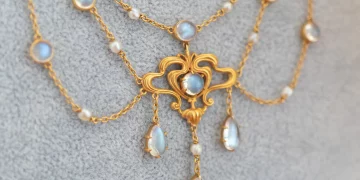When the name Paloma Picasso is mentioned in the realm of luxury jewelry, it conjures up images of timeless elegance, bold sophistication, and creative innovation. As one of the most celebrated jewelry designers in the world, Paloma Picasso’s designs have been recognized not only for their luxurious appeal but also for their deep cultural connections and personal artistic vision. Her creations continue to embody the pinnacle of luxury while reflecting her unique ability to combine tradition with modernity in ways that transcend trends.
But what is it that makes Paloma Picasso’s jewelry so revered as a symbol of luxury? What is the core of her design philosophy? And how does she draw inspiration from art, culture, and personal history to create jewelry that is both timeless and innovative?
In this article, we will explore why Paloma Picasso’s jewelry has become a luxury icon, and how her cultural influences, artistic creativity, and personal journey are intricately woven into each piece she designs.
1. Paloma Picasso’s Journey to Luxury Jewelry Design
Before becoming the designer of world-renowned jewelry pieces, Paloma Picasso was already well-known for her artistic heritage as the daughter of Pablo Picasso, one of the most famous and influential artists of the 20th century. Her early exposure to art, design, and creativity played a pivotal role in shaping her career as a jewelry designer.
1.1 A Legacy of Artistic Influence
Growing up in a world surrounded by artistic genius, Paloma Picasso was immersed in the avant-garde and creative environment that defined her father’s legacy. From an early age, she was exposed to her father’s artistic works, which spanned painting, sculpture, and ceramics, and she was deeply inspired by the process of artistic expression.
- Picasso’s connection to art history, bold forms, and geometric abstraction heavily influenced Paloma’s approach to jewelry design. She later remarked that her father’s legacy allowed her to freely explore her own creative instincts without feeling bound by the expectations that often come with traditional luxury design.
1.2 Design Collaboration with Tiffany & Co.
In 1980, Paloma Picasso’s career reached a major milestone when she began working with Tiffany & Co., one of the most prestigious jewelry houses in the world. Her debut collection for Tiffany was an instant success, combining modern design with luxury craftsmanship. Her collections, including the Paloma’s Graffiti, Paloma’s Star, and Paloma’s Melody lines, captivated the jewelry world, and her name became synonymous with luxury.
- Her designs for Tiffany continue to embody the brand’s philosophy of timeless elegance, while offering a distinctive, contemporary edge that sets them apart from the more traditional luxury pieces. Her ability to inject a sense of boldness and playfulness into the world of luxury allowed her to carve out her own unique place in the high-end jewelry market.
2. The Design Philosophy Behind Paloma Picasso’s Jewelry
Paloma Picasso’s jewelry is not merely about creating beautiful accessories; it’s about creating art that speaks to the soul. Her designs are a reflection of her artistic vision, personal journey, and emotional connection to the world around her.
2.1 Boldness and Playfulness: A Signature of Paloma Picasso
One of the key attributes that define Paloma Picasso’s jewelry is its boldness. She has a distinctive ability to blend dramatic, sculptural elements with elegant simplicity. Whether it’s through the use of curves, geometric shapes, or vibrant color combinations, her jewelry consistently stands out as an artistic statement.
- For example, her heart-shaped pieces—like the Heart Necklace—are not soft, romantic, or overly sentimental; instead, they exude strength and confidence, turning a traditionally delicate symbol into something empowered and defiant.
- Picasso’s use of color and contrast also plays a pivotal role in her signature style. Often, she incorporates vivid gemstones, such as turquoise, emeralds, and coral, which are vibrant against more neutral metals like gold or silver. This bold contrast is often used to redefine beauty in luxury, giving her pieces a striking, modern edge while preserving their elegant appeal.
2.2 Cultural and Historical Influences in Her Designs
Paloma Picasso draws heavily from the rich cultural tapestry of her own life, as well as from art history and global design traditions. Her jewelry pieces often reflect her deep appreciation for art and culture, while also celebrating her unique position as a global citizen with diverse influences.
2.2.1 Inspiration from Picasso’s Art
Her father’s artwork—known for its bold, experimental styles—is a constant influence in her jewelry. Much like Pablo Picasso’s mastery of cubism and surrealism, Paloma’s jewelry embraces abstract forms and geometric designs.
- Her graffiti-inspired jewelry collection is one such example. The handwritten script, swirls, and lines evoke a sense of freedom and individual expression, akin to the energetic mark-making that her father often used in his works.
- Additionally, organic shapes often find their way into her designs. She might use curves and asymmetry that mirror the fluid lines in her father’s paintings and sculptures, creating a sense of movement and dynamism within the jewelry.

2.2.2 Cultural and Geometric Influences
Throughout her career, Paloma Picasso has traveled extensively, and these global experiences have influenced the ethnic and cultural motifs she often integrates into her designs. Her works often include elements inspired by African, Asian, and Middle Eastern art, from tribal motifs to oriental patterns.
- The use of geometric shapes like circles, triangles, and squares in many of her designs is a nod to her father’s cubist style, but also reflects her personal fascination with mathematical beauty and the harmony of shapes.
- Additionally, the use of bold color in her designs is reflective of ethnic jewelry traditions around the world, which emphasize the symbolism of colors and materials.
2.3 The Intersection of Feminism and Elegance
Paloma Picasso’s jewelry is frequently seen as a celebration of women’s strength and individuality. Many of her pieces convey a sense of empowerment, offering a new perspective on luxury jewelry that is not solely about decoration, but about self-expression.
- Her designs, such as the love knot bracelet or the bold cuffs, are not about being passive or decorative, but about offering a sense of empowered confidence to the wearer. The jewelry makes a statement about personal freedom and the ability to define one’s own beauty.
- By focusing on the unconventional beauty of women and celebrating their authenticity, Paloma Picasso’s jewelry reinforces a modern understanding of what it means to be luxurious—it’s not about conforming to standards, but about embracing individuality.
3. Paloma Picasso’s Jewelry as a Luxury Symbol
The reason Paloma Picasso’s jewelry has become a luxury symbol is due to its perfect combination of artistic integrity, cultural depth, and uncompromising craftsmanship. While the designs are undeniably luxurious, it is their authenticity, boldness, and personal touch that set them apart.
3.1 Masterful Craftsmanship and Timeless Elegance
Paloma Picasso’s jewelry is not only visually stunning but is also meticulously crafted. Every piece is made using the highest standards of luxury craftsmanship, ensuring that the pieces are timeless and durable. Each piece is built to withstand both fashion trends and the test of time, reflecting the enduring nature of Picasso’s design vision.
- Her use of precious gemstones, high-quality metals, and intricate detailing elevates her jewelry to the level of true luxury, while maintaining the creativity and vision that make her pieces stand out in the competitive world of high jewelry.
3.2 A Personal Connection to the Wearer
What truly makes Paloma Picasso’s jewelry stand out as a symbol of luxury is the emotional and personal connection it creates with the wearer. Each piece carries a narrative and an artistic story—whether it’s about empowerment, love, or individual expression.
- Her jewelry is meant to be more than just an accessory. It is a statement of identity, self-expression, and a reflection of personal taste. In this way, the jewelry goes beyond its material value—it becomes a piece of art that carries deep emotional resonance for its wearer.
Conclusion: Paloma Picasso as a Symbol of Modern Luxury
Paloma Picasso’s jewelry is the epitome of modern luxury—a fusion of artistic heritage, bold innovation, and cultural influence. Through her designs, she has redefined the concept of luxury jewelry, turning it into an art form that celebrates the individual, femininity, and personal expression. Her work continues to inspire both those within the jewelry industry and the fashion world, reminding us that luxury is not just about precious materials but about the artistic narrative behind each design. Paloma Picasso’s jewelry will undoubtedly remain a symbol of luxury, elegance, and artistic brilliance for generations to come.

















































